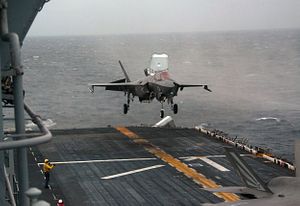F-35B fighter jets aboard the first-of-class amphibious assault ship USS Wasp (LHD 1) conducted the first-ever shipboard hot reload of ordnance in the Indo-Pacific region in the Solomon Sea on August 4, the U.S. Navy said in a statement.
The F-35Bs, the U.S. Marine Corps variant of the supersonic fifth-generation F-35B Lightning II Joint Strike Fighter, capable of vertical or short takeoffs and vertical landings without requiring a catapult launcher, used their GAU-22 cannon against a simulated inflatable target drifting on the ocean’s surface.
“During the training flights, F-35B jets fired the 25mm cannon in coordination with MV-22B Osprey tiltrotor aircraft and Navy MH-60S Sea Hawk helicopters firing 7.62 mm machine guns to destroy the ‘killer tomato’, a large inflatable target used during live-fire exercises at sea,” the statement reads. The GAU-22 is able to fire 3,300 rounds per minute from its four barrels with a high degree of accuracy.
Additionally, the F-35Bs dropped a GBU-32 1,000-pound Joint Direct Attack Munition, and a GBU-12 Paveway II 500-pound laser-guided bomb on a simulated target. “After expending all ordnance, the aircraft returned to the Wasp, reloaded and refueled, and executed a second live-fire sortie,” according to the Navy. The GBU 12 and GBU 32 are general purpose bombs.
The F-35B conducted its first close air support strike in Afghanistan in September 2018. During its first combat sortie, the stealth aircraft dropping a GBU-32 Joint Direct Attack Munition (JDAM) weapon fitted on an external weapon pod. The aircraft took off from the Wasp-class amphibious assault ship USS Essex cruising in the Arabian Sea.
In February of this year, F-35Bs from the USS Wasp conducted bomb drops on simulated targets in the Philippine and East China Seas. The USS Wasp is the size of a small aircraft carrier and can carry around 31 military aircraft including AV-8B Harrier IIs, MH-60S Knighthawk helicopters, AH-1Z Viper helicopters, and MV-22 Osprey tiltrotor aircraft. In 2017, the Wasp underwent upgraded to carry six F-35Bs.
The U.S. Marine Corps procured the F-35B to replace the service’s F/A-18 Hornet, AV-8B Harrier and EA- 6B Prowler aircraft.
The USS Wasp expeditionary strike group (ESG) deployed to the naval port of Sasebo, Japan, in January 2018, replacing her sister ship USS Bonhomme Richard as the biggest forward-deployed amphibious assault ship in the U.S. Navy’s 7th Fleet. The Wasp is also the flagship of Task Force 76, which includes all of the 7th Fleet amphibious forces.
The USS Wasp in turn will be replaced by the first-of-class USS America. America-class amphibious assault ships can carry up to 10 F-35Bs. The America is currently underway on a training mission, while the second ship of the class, the future USS Tripoli recently successfully completed builder’s trials in the Gulf of Mexico.

































